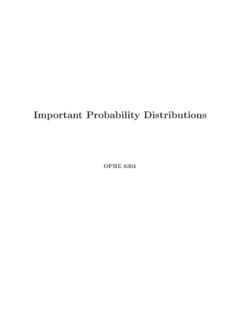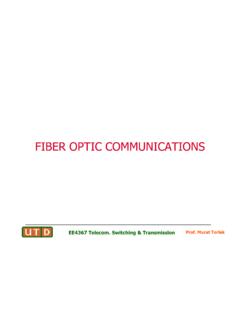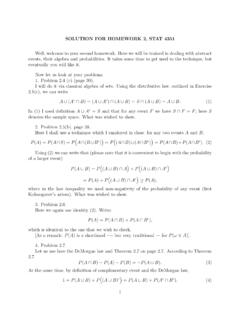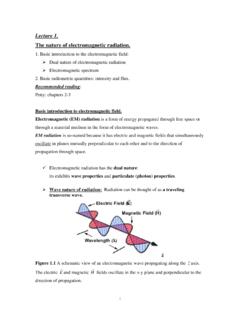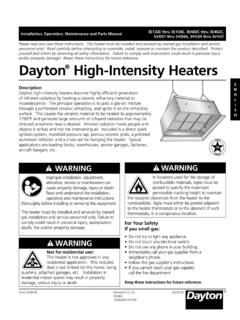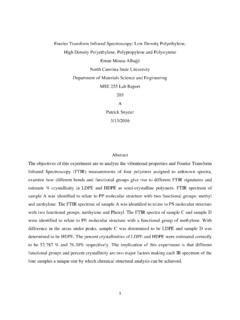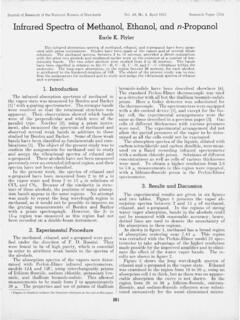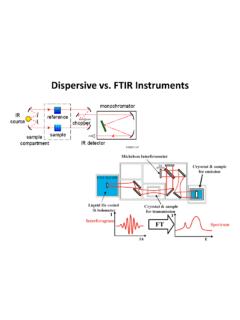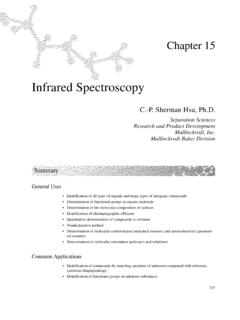Transcription of INFRARED SPECTROSCOPY (IR)
1 1 INFRARED SPECTROSCOPY (IR)Theory and Interpretation of IR spectraASSIGNED READINGS Introduction to technique 25 (p. 833-834 in lab textbook) Uses of the INFRARED Spectrum (p. 847-853) Look over pages 853-866 after viewing this presentation for additional examples of various functional groups. Emphasis is on data interpretation, not on data memorization. 2 ORGANIC STRUCTURE DETERMINATIONHow do we know: how atoms are connected together? Which bonds are single, double, or triple? What functional groups exist in the molecule? If we have a specific stereoisomer?
2 The field of organic structure determination attempts to answer these METHODS OF STRUCTURE Magnetic Resonance (NMR) Excitation of the nucleus of atoms through radiofrequency irradiation. Provides extensive information about molecular structure and atom SPECTROSCOPY (IR) Triggering molecular vibrations through irradiation with INFRARED light. Provides mostly information about the presence or absence of certain functional spectrometry Bombardment of the sample with electrons and detection of resulting molecular fragments. Provides information about molecular mass and atom SPECTROSCOPY (UV) Promotion of electrons to higher energy levels through irradiation of the molecule with ultraviolet light.
3 Provides mostly information about the presence of conjugated systems and the presence of double and triple stimulusMoleculeresponseDetecting instrumentVisual (most common)representation, orSpectrumSPECTROSCOPY - Study of spectral informationUpon irradiation with INFRARED light, certain bonds respond by vibrating faster. This response can be detected and translated into a visual representation called a INTERPRETATION PROCESS1. Recognize a Associate patterns with physical Identify possible meanings, propose a spectrum is obtained, the main challenge is to extract the information it contains in abstract, or hidden requires the recognition of certain patterns, the association of these patterns with physical parameters, and the interpretation of these patterns in terms of meaningful and logical SPECTRUMMost organic SPECTROSCOPY uses electromagnetic energy, or radiation,as the physical energy (such as visible light) has no detectable mass component.
4 In other words, it can be referred to as pure energy. Other types of radiation such as alpha rays, which consist of helium nuclei, have a detectable mass component and therefore cannot becategorized as electromagnetic important parameters associated with electromagnetic radiation are: Energy (E): Energy is directly proportional to frequency, and inversely proportional to wavelength, as indicated by the equation below. Frequency ( ) Wavelength ( )E = h EFFECT OF ELECTROMAGNETIC RADIATION ON MOLECULESG raphics source: Wade, Jr., Organic Chemistry, 5th ed.
5 Pearson Education Inc., 2003 5 INFRARED radiation is largely thermal induces stronger molecular vibrationsin covalent bonds, which can be viewed as springs holding together two masses, or source: Wade, Jr., Organic Chemistry, 5th ed. Pearson Education Inc., 2003 Specificbonds respond to (absorb) specificfrequenciesVIBRATIONAL MODES Covalent bonds can vibrate in several modes, including stretching, rocking, and scissoring. The most useful bands in an INFRARED spectrum correspond to stretching frequencies, and those will be the ones we ll focus source: Wade, Jr.
6 , Organic Chemistry, 5th ed. Pearson Education Inc., 2003 6 TRANSMISSION vs. ABSORPTIONWhen a chemical sample is exposed to the action of IR LIGHT, it can absorbsome frequencies and transmitthe rest. Some of the light can also be reflected back to the lightFrom all the frequencies it receives, the chemical samplecan absorb (retain)specific frequencies and allow the rest to pass through it (transmitted light).DetectorThe detector detects the transmitted frequencies, and by doing so also reveals the values of the absorbed IR SPECTRUM IN ABSORPTION MODEThe IR spectrum is basically a plot of transmitted (or absorbed) frequencies vs.
7 intensity of the transmission (or absorption). Frequencies appear in the x-axis in units of inverse centimeters (wavenumbers), and intensities are plotted on the y-axis in percentage graph above shows a spectrum in IR SPECTRUM IN TRANSMISSION MODEThe graph above shows a spectrum in is the most commonly used representationand the one found in most chemistry and SPECTROSCOPY books. Therefore we will use this OF IR BANDSIR bands can be classified as strong(s), medium(m), or weak(w), depending on their relative intensities in the INFRARED spectrum. A strong band covers most of the y-axis.
8 A medium band falls to about half of the y-axis, and a weak band falls to about one third or less of the ACTIVE BONDSNot all covalent bonds display bands in the IR spectrum. Only polar bonds do so. These are referred to as IR intensity of the bands depends on the magnitude of the dipole momentassociated with the bond in question: Strongly polar bonds such as carbonyl groups (C=O) produce strong bands. Medium polarity bonds and asymmetric bonds produce medium bands. Weakly polar bond and symmetric bonds produce weak or non observable BAND SHAPESI nfrared band shapes come in various forms.
9 Two of the most common are narrowand broad. Narrow bands are thin and pointed, like a dagger. Broad bands are wide and typical example of a broad band is that displayed by O-H bonds, such as those found in alcohols and carboxylic acids, as shown OBTAINED FROM IR SPECTRA IR is most useful in providing information about the presence or absence of specific functional groups. IR can provide a molecular fingerprintthat can be used when comparing samples. If two pure samples display the same IR spectrum it can be argued that they are the same compound. IR does notprovide detailed information or proof of molecular formula or structure.
10 It provides information on molecular fragments, specifically functional groups. Therefore it is very limited in scope, and must be used in conjunction with other techniques to provide a more complete picture of the molecular ABSORPTION RANGEThe typical IR absorption range for covalent bonds is 600 - 4000 cm-1. The graph shows the regions of the spectrum where the following types of bonds normally absorb. For example a sharp band around 2200-2400 cm-1would indicate the possible presence of a C-N or a C-C triple source: Wade, Jr., Organic Chemistry, 5th ed.
